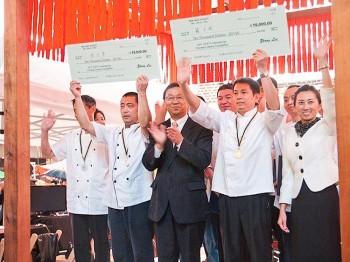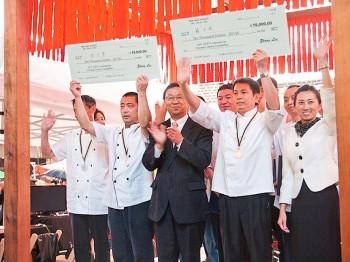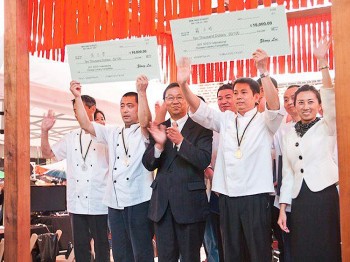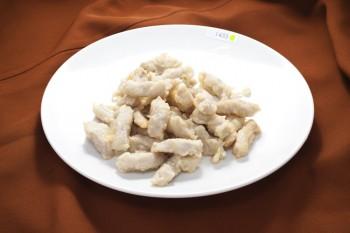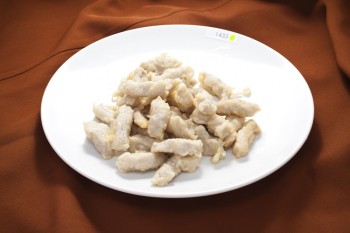The atmosphere at Times Square was a celebratory one on Friday night despite the drizzling rain. Excitement filled the air as the results for the final round of the International Chinese Culinary Competition were announced.
The competition, hosted by New Tang Dynasty Television (NTD), concluded with Northeastern cuisine contestant Zhixue Zhang and Cantonese cuisine contestant Robin Luo as the gold winners.
Winning Dishes
Zhang’s winning dish was Quick Boiled Sour Cabbage with Pork, a classic Northeastern dish that is usually eaten in the winter. Though the ingredients are rather simple, it takes experience and skill to make it especially tasty.
The sour cabbage should be carefully chopped into thin strips, and the pork must be boiled until it will melt in one’s mouth. A balance of taste should be established between the pork and the cabbage, and the chef must control the amount of soup carefully so that the dish is not too dry or watery. One of the most important elements of the dish is how long it is boiled. The cooking technique for the dish is called “quick boil,” therefore the chef must have precise timing and nimble fingers.
Soft-Fried Tenderloin Slices was the dish that Zhang chose as his self selected dish in the preliminary round. Each contestant in the final round was required to cook two required dishes and one self-selected dish. After being marinated with corn starch, salt, and other ingredients, the pork loin pieces must be fried twice. They should only be half cooked the first time, dipped in and egg batter, then fried again.
One dish that Luo prepared was White Fish in Oil. The dish largely depends on the quality of the fish, but can truly demonstrate the chef’s skills in seasoning, boiling, and time control. Luo carefully slits the fish so that flavor will permeate the flesh. The entire fish is boiled, then immersed in soy sauce and salt. Finally, he topped it off with some finely sliced green onion. Throughout the preparation, the chef needs to maintain the perfect temperature to ensure that the fish is cooked through.
The two winning chefs demonstrated the distinct features of their regional categories through their dishes. Northeastern cuisine largely uses casserole and marinating techniques. Dishes are tender but not rare, well done but not tough. Cantonese cuisine on the other hand, is known for its steaming techniques, fresh ingredients, especially seafood, and a lighter flavor profile compared to other cuisines.
Another dish worth mentioning from the competition is Kung Pao Chicken, which appeared many times throughout the competition. Kung Pao Chicken, or directly translated as Palatial Garden Chicken, is a famous Szechuan dish known by most Chinese and many Westerners. It was named after a senior officer in ancient China who loved the dish so much that he became well-known for ordering it.
Traditionally, Kung Pao Chicken is diced chicken pieces stir-fried with dried chili peppers, peanuts, and sweet and sour seasoning. While it is popular in Western countries, it is rarely cooked with traditional ingredients and techniques. It is a great representation of the Szechuan cuisine, which is famous for stir-fried dishes, spicy seasoning, and mixture of flavors.
Diverse Culinary Techniques
The contestants have in-depth understanding of the origin and development of their respective regional cuisines. Through preparing the dishes, they showcased their knowledge in traditional Chinese culinary arts and skill in various cooking techniques.
Different techniques were developed in different regions, depending on what natural resources are available, the weather, and other environmental factors. For example, Szechuan cuisine uses over 40 cooking techniques on its own because of the abundance of agricultural products native to the area. Oxen is especially plentiful in the Szechuan Province, therefore many dishes have beef as a main ingredient. Beef is best cooked stir-fried, braised, or steamed, so those are the three most common techniques used.
Shandong cuisine emphasized the techniques of “bao” and “ta.” Bao is the act of quick stir-frying, and is a great way to preserve nutrients, since the food is not overcooked. Ta, a special way of frying food, is a cooking method unique to Shandong cuisine. Many Shandong dishes are spiced, starched, Ta-fried, then simmered in soup or sauce.
“We emphasize traditional Chinese cooking techniques,” said Yunqiang Qu, president of the competition’s judge committee. “For example, if a dish requires you to ’stir-fry only with hot oil,' then that technique must be used. This is part of his regional cuisine, and only that technique can produce the taste required for that dish. Many contestants have neglected this, but this is actually the fundamental factor.”
NTD hosted the International Chinese Culinary Competition to revive traditional Chinese culinary techniques and methods, promote authentic Chinese culinary philosophy, and promote traditional Chinese culinary culture.

